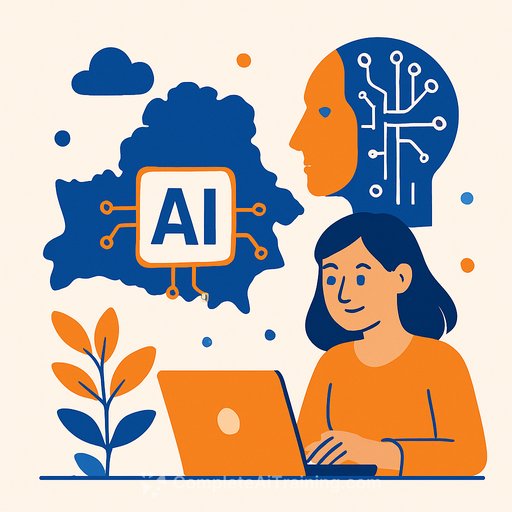AI in Belarus: Practical Steps for Builders and Policymakers
AI is no longer an experiment. Global investment has tripled in four years, and the count of countries with national AI strategies has grown more than fivefold in six. Belarus is in the mix, building capacity piece by piece. The question is how to convert intent into deployable systems and measurable outcomes.
Human development risks and where AI actually helps
The 2025 Human Development Report shows the Human Development Index declining for the first time in three decades, with inequality rising again. AI can still move the needle if we focus on real use cases. Healthcare gets earlier diagnoses with machine learning. Education gets adaptive content. Industry and infrastructure get optimization and better energy management.
The paradox: growth vs. divide
Global surveys reflect a split mindset. Sixty percent expect AI to improve jobs; one in eight worries about losing theirs. In developing economies, 70% expect productivity gains, yet digital skills lag. Without skills and access, benefits stay concentrated.
Belarus snapshot: progress, gaps, and signals
Belarus ranks 113th of 160 on AI adaptation. Forty-three percent of citizens have never used AI, close to the global estimate that 36% have zero interaction. At the same time, 57% believe tech will help solve big problems, while 21% see new risks on the horizon.
Awareness of training is decent: about 60% know of programs in data analysis and machine learning. The blockers are familiar to engineers and educators: a shortage of qualified teachers and uneven access across regions. That mismatch slows talent pipelines and adoption in production settings.
Policy and infrastructure: moves made, awareness low
Belarus launched belai.by in 2022 to connect AI specialists and contributed a model "On Artificial Intelligence" law for CIS countries in 2023. These are solid building blocks. Yet 73% of surveyed respondents are unaware of state programs for AI, and 67% cannot say if relevant legislation exists. The policy work is there; the signal is not reaching practitioners and companies.
What builders can do now
- Start with narrow, high-ROI use cases: document Q&A with retrieval, claims triage, demand forecasting, anomaly detection. Define success metrics upfront.
- Establish data foundations: clear ownership, lineage, access controls, and audit trails. Prioritize high-quality labeled datasets for supervised tasks.
- Ship with guardrails: implement prompt and output filtering, PII detection, red-teaming, and human-in-the-loop for sensitive workflows.
- Choose pragmatic stacks: Python, PyTorch, Transformers, ONNX Runtime, OpenVINO for CPU/edge, vector databases for retrieval. Optimize with quantization and batching to offset GPU constraints.
- Treat evaluation as a product: build test suites for accuracy, latency, cost, and drift. Add offline benchmarks and online A/B tests. Track incident reports like any other reliability metric.
- Adopt a risk framework: map use cases to impact levels and controls. The NIST AI Risk Management Framework is a practical starting point.
- Upskill continuously: engineers need LLM ops, data teams need feature and label quality, and product teams need prompt design and evaluation. See structured paths by skill at Complete AI Training.
Enterprise and public-sector playbook
- Compute strategy: inventory current capacity, set shared GPU pools, and use scheduling to keep utilization high. For cost control, mix local inference with selective cloud APIs.
- Public data assets: publish high-value, privacy-safe datasets (transport, energy, agriculture). Support synthetic data where real data is scarce.
- Teacher pipeline: fund micro-credentials for instructors in data science and ML. Pair universities with industry for project-based courses.
- Regional labs: create small applied AI hubs outside major cities with shared tooling and mentorship to reduce geographic inequality.
- Procurement that buys outcomes: define measurable targets (accuracy, time saved, energy used per inference), not just licenses.
- Regulatory sandbox: enable time-boxed pilots with reporting, to de-risk novel use cases without slowing deployment.
- SME vouchers: co-finance audits, prototypes, and first deployments for small and mid-sized firms.
- Model risk policy: require documentation, evaluation reports, and incident response plans for any model in production.
Metrics that matter
- Adoption: percent of organizations with AI in production and number of active use cases per org.
- Time to value: days from idea to pilot, and pilot to production.
- Quality: task accuracy, business KPIs moved, user satisfaction, and error/incident rates.
- Cost and efficiency: unit cost per prediction, energy per 1,000 inferences, GPU hours per release.
- Skills: percent of workforce with baseline AI literacy; number of certified practitioners; regional distribution of trained talent.
Belarus' window of opportunity
AI access is getting easier and the application space is wide. Belarus has momentum in policy and community, plus a population that is cautiously optimistic. Converting that into production systems requires three parallel tracks: build shared infrastructure, scale talent, and open channels between government, academia, and business.
Technology is a tool; outcomes come from who uses it and why. With clear use cases, skilled teams, and practical guardrails, Belarus can raise productivity and reduce inequality at the same time.
Your membership also unlocks:






